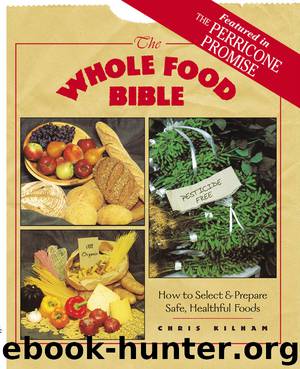The Whole Food Bible by Christopher S. Kilham

Author:Christopher S. Kilham
Language: eng
Format: epub
Publisher: Inner Traditions / Bear & Company
Published: 2012-04-29T16:00:00+00:00
Nutritional Information
According to Food and Drug Administration regulations, the amount of specific nutrients must be listed according to serving size. A product’s serving size is a totally arbitrary measure that is not based on how much of a product is typically eaten. If ½ cup is the serving size for a cereal, then the nutritional information on the label will be for ½ cup of that product. Nutritional information will include calories, protein, fat, and carbohydrate content. In addition, percentages of the U.S. Recommended Dietary Allowances (U.S. RDAs) for protein, vitamins A and C, thiamin, riboflavin, niacin, calcium, and iron must be given.
Nutrients are added to products to restore nutrients lost in processing or to correct dietary deficiencies in the general population. Nutrients are added to white bread, for example, because it is an inferior product that has been stripped of its natural nutritional value. Adding some synthetic vitamins to white bread gives it at least some meager nutritional worth. Adding vitamin D to milk, on the other hand, is done simply to prevent rickets in children.
Many of the synthetic nutrients added to foods contain several preservatives. These will never be listed on a product label. Vitamin A added to milk may contain as many as ten or more preservatives. Despite this, the milk container needs only to say “vitamin A added” without mention of the preservatives.
Here’s a typical nutrition panel:
Download
This site does not store any files on its server. We only index and link to content provided by other sites. Please contact the content providers to delete copyright contents if any and email us, we'll remove relevant links or contents immediately.
| Antioxidants & Phytochemicals | Caffeine |
| Cancer Prevention | Fiber |
| Food Additives | Food Allergies |
| Genetically Engineered Food | Macrobiotics |
| Vitamins & Supplements |
Nutrition for Sport, Exercise, and Health by Spano Marie & Kruskall Laura & Thomas D. Travis(3741)
Nutrition for Sport, Exercise, and Health by Marie Spano & Laura Kruskall & D. Travis Thomas(3705)
The Sprouting Book by Ann Wigmore(3561)
Flavor Flours by Alice Medrich(2827)
Superfood Smoothie Bowls: Delicious, Satisfying, Protein-Packed Blends that Boost Energy and Burn Fat by Chace Daniella(2418)
Memory Rescue by Daniel G. Amen(2396)
Dirty Genes by Ben Lynch(2291)
The Bad Food Bible by Aaron Carroll(2245)
Genius Foods by Max Lugavere(2194)
The Poisoner's Handbook by Deborah Blum(2108)
Good Calories, Bad Calories by Gary Taubes(2085)
The Main Street Vegan Academy Cookbook by Victoria Moran(2054)
The I Quit Sugar Cookbook by Sarah Wilson(2018)
Core Performance Essentials by Mark Verstegen(1992)
Memory Rescue: Supercharge Your Brain, Reverse Memory Loss, and Remember What Matters Most by Amen Dr. Daniel G(1957)
Big Girls Do It Stronger by Jasinda Wilder(1918)
Android App Development by Franceschi Hervé J.;(1827)
Sugar Crush by Dr. Richard Jacoby(1782)
Dr. Colbert's Keto Zone Diet by Don Colbert(1636)
